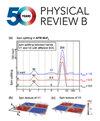Translation symmetry restoration under random unitary dynamics
IF 3.7
2区 物理与天体物理
Q1 Physics and Astronomy
引用次数: 0
Abstract
The finite parts of a large, locally interacting many-body system prepared out of equilibrium eventually equilibrate. Characterizing the underlying mechanisms of this process and its timescales, however, is particularly hard as it requires one to decouple universal features from observable-specific ones. Recently, additional insight was gained by studying how certain symmetries of the dynamics that are broken by the initial state are restored at the level of the reduced state of a given subsystem. This provides a high-level, observable-independent probe. Until now, this idea has been applied to the restoration of internal symmetries, e.g., U(1) symmetries related to charge conservation. Here we show that the same logic can be applied to the restoration of space-time symmetries, and hence can be used to characterize the relaxation of fully generic systems. We illustrate this idea by considering the paradigmatic example of “generic” many-body dynamics, i.e., a local random unitary circuit, where our method leads to exact results. We show that the restoration of translation symmetry in these systems only happens on timescales that are proportional to the subsystem's volume. In fact, for large enough subsystems, the time of symmetry restoration becomes initial-state independent (as long as the latter breaks the symmetry at time zero) and coincides with the thermalization time. For intermediate subsystems, however, one can observe the “quantum Mpemba effect,” where the state of the system restores a symmetry faster if it is initially more asymmetric. We provide an exact characterization of this effect in a nonintegrable system.随机酉动力下的平移对称性恢复
一个大型的、局部相互作用的多体系统的有限部分在脱离平衡状态时最终达到平衡。然而,描述这一过程的潜在机制及其时间尺度尤其困难,因为它要求人们将普遍特征与可观察到的特定特征解耦。最近,通过研究如何在给定子系统的简化状态水平上恢复被初始状态破坏的动力学的某些对称性,获得了额外的见解。这提供了一个高级的、与观测无关的探测。到目前为止,这一想法已被应用于内部对称性的恢复,例如与电荷守恒相关的U(1)对称性。在这里,我们证明了相同的逻辑可以应用于时空对称性的恢复,因此可以用来表征完全泛型系统的弛豫。我们通过考虑“一般”多体动力学的范例来说明这个想法,即,一个局部随机酉电路,我们的方法导致精确的结果。我们证明了这些系统中平移对称性的恢复只发生在与子系统体积成正比的时间尺度上。事实上,对于足够大的子系统,对称恢复时间变得与初始状态无关(只要后者在时间为零时打破对称),并且与热化时间一致。然而,对于中间子系统,人们可以观察到“量子姆潘巴效应”,即如果系统的初始状态不对称,则系统的状态恢复对称的速度会更快。我们给出了在不可积系统中这种效应的精确表征。2025年由美国物理学会出版
本文章由计算机程序翻译,如有差异,请以英文原文为准。
求助全文
约1分钟内获得全文
求助全文
来源期刊

Physical Review B
物理-物理:凝聚态物理
CiteScore
6.70
自引率
32.40%
发文量
0
审稿时长
3.0 months
期刊介绍:
Physical Review B (PRB) is the world’s largest dedicated physics journal, publishing approximately 100 new, high-quality papers each week. The most highly cited journal in condensed matter physics, PRB provides outstanding depth and breadth of coverage, combined with unrivaled context and background for ongoing research by scientists worldwide.
PRB covers the full range of condensed matter, materials physics, and related subfields, including:
-Structure and phase transitions
-Ferroelectrics and multiferroics
-Disordered systems and alloys
-Magnetism
-Superconductivity
-Electronic structure, photonics, and metamaterials
-Semiconductors and mesoscopic systems
-Surfaces, nanoscience, and two-dimensional materials
-Topological states of matter
 求助内容:
求助内容: 应助结果提醒方式:
应助结果提醒方式:


